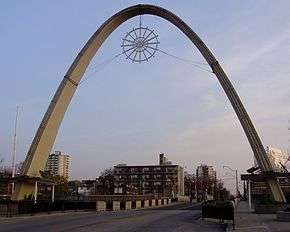Dufferin Street bridges
| Dufferin Street Truss Bridge/Dufferin Street Overpass | |
|---|---|
 The Dufferin Street bridges over the Gardiner Expressway and the rail line from the west. | |
| Coordinates | 43°38′03″N 79°25′31″W / 43.634087°N 79.425402°WCoordinates: 43°38′03″N 79°25′31″W / 43.634087°N 79.425402°W |
| Carries | Pedestrians and Vehicular |
| Crosses | Metrolinx/GO Transit rail corridor |
| Locale | Toronto, Ontario, Canada |
| Maintained by | Toronto Transportation Services |
| Characteristics | |
| Material | Steel and Concrete |
| Total length |
30 metres (98 ft) (rail bridge) 35 metres (115 ft) (overpass) |
| No. of spans | 2 |
| Clearance above | 6.37 metres (20.9 ft) (rail bridge) |
| History | |
| Construction start |
1911 1958 |
| Construction end |
1912 (rail bridge) 1958 (overpass) |
| Opened |
1912 1959 |
| Closed | 2013 |
The Dufferin Street bridges are two inter-connected vehicular bridges in Toronto, Ontario, Canada. The bridges carry Dufferin Street over a railway corridor and the Gardiner Expressway to Exhibition Place. The bridges closed to vehicular traffic in 2013. Temporary structures will be built in 2013-2014 to allow a resumption of traffic in early 2014.[1] Beginning in 2016 the bridges will be completely rebuilt to allow more tracks to cross underneath and create a single span to the CNE grounds.[2]
North span
The truss bridge is a 30 metres (98 ft) steel truss bridge, built from 1911 to 1912 to cross over railway tracks south of Springhurst Avenue. Four tracks pass under the bridge. A 2013 engineering study determined that the bridge was unsafe and not viable to be repaired.[3]
South span
The south span is a 35 metres (115 ft) concrete overpass built in 1958 after demolition of the old Dufferin Gate to allow for clearance for the Gardiner Expressway below[4][5] and will be replaced after 2016 along with the north span in 2016.[3]
Deterioration and replacement
After a report from external inspections conducted in 2007 the city decided to replace both spans with a single span:[5]
- 1911 bridge over rail corridor is structurally unsafe for vehicular traffic
- lack space below to expanded rail corridor
- need to provide space for future LRT corridor to the south end of the bridge
- 1958 bridge over Gardiner Expressway needs maintenance to keep it structurally safe
- eliminate the existing 10 metres (33 ft) gap between the two existing bridges spans
From June 2013 the bridges have been closed to vehicular traffic. Starting in November 2013, the north bridge superstructure will be replaced by three temporary bridges - two for traffic, and a third for pedestrians. These will open in early 2014. The temporary bridges will be used until 2016, when construction will begin on a new bridge to replace the two current spans.[6]
City is deciding the type of bridge that will span over the tracks.[7]
- steel plate box girder
- hung arch
- cable stay
- concrete box girder
Gallery
 View of Dufferin Street bridge showing deterioration.
View of Dufferin Street bridge showing deterioration. Looking north from Dufferin Gate with overpass in foreground and truss bridge in background
Looking north from Dufferin Gate with overpass in foreground and truss bridge in background
References
- ↑ "Deteriorating Dufferin Street bridge to close for 18 months". Citynews.ca. 2013-06-03. Retrieved 2013-11-04.
- ↑ City of Toronto Staff. "City of Toronto: Get involved". Toronto.ca. Archived from the original on 2013-06-24. Retrieved 2013-11-04.
- 1 2 "Dufferin Bridges: Appendix E: Structural Options Evaluation" (PDF). City of Toronto.
- ↑ "A brief history of the Dufferin Gate at the CNE grounds". Blogto.com. 2012-01-28. Retrieved 2013-11-04.
- 1 2 "Dufferin Bridges: Municipal Class Environmental Assessment" (PDF). City of Toronto.
- ↑ "Dufferin Street Bridge Demolition and Installation of Temporary Crossing" (PDF). gordperks.ca.
- ↑ LEA Consulting Ltd. (10 March 2011). "Structural Engineering Evaluation" (PDF). Dufferin Bridge EA Study. City of Toronto. Retrieved February 2016. Check date values in:
|accessdate=(help)